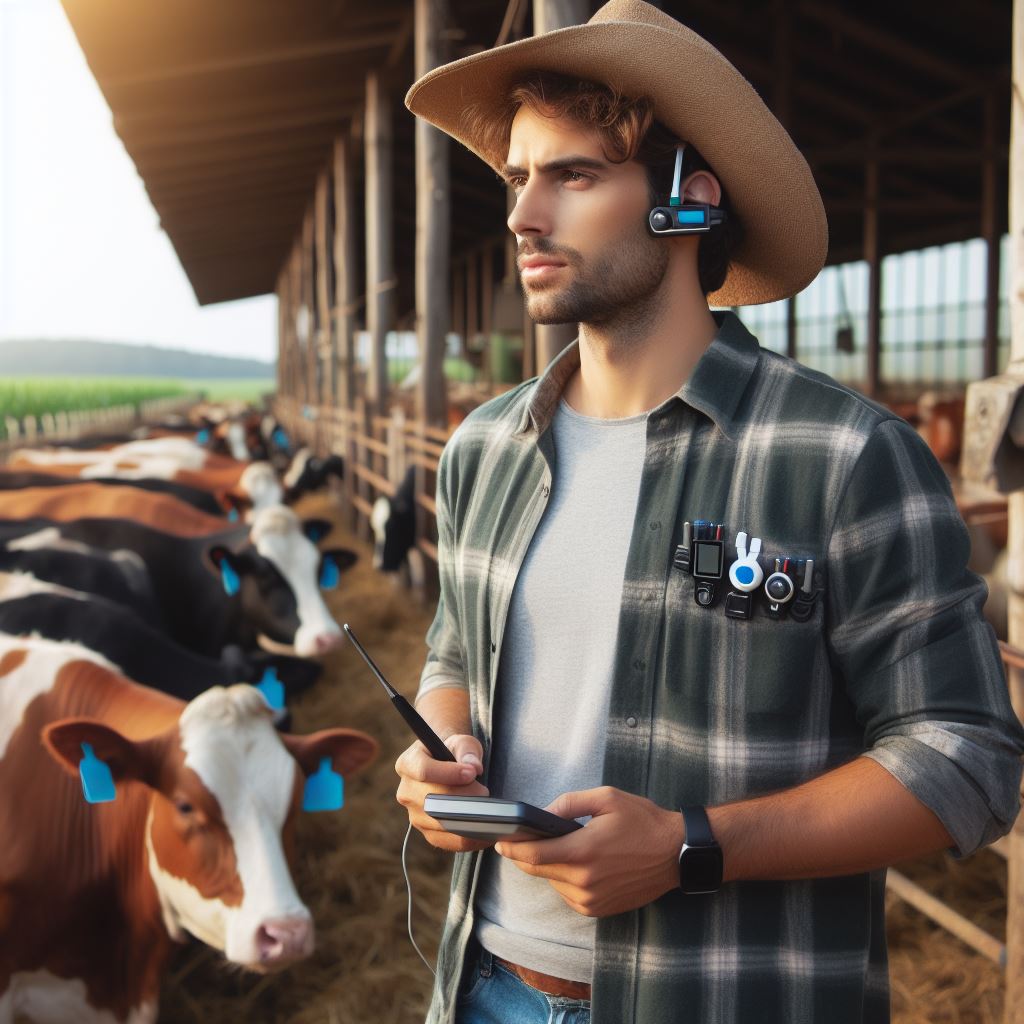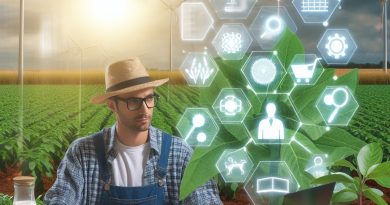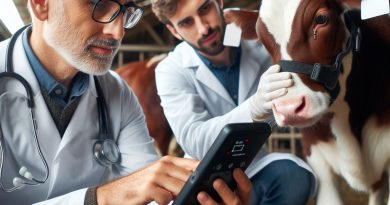Sensor Tech in Livestock Care: An Insight
Last Updated on March 2, 2024
Introduction
Livestock health is vital for ethical, sustainable farming, and sensor tech allows proactive care.
Sensors monitor animal behavior and welfare, providing data to enhance nutrition, treat illness, improve welfare, and increase farm productivity.
This technology is transforming livestock management across the globe. Sensors track temperature, movement, feeding patterns, and other variables, transmitting real-time data.
Fitted in ear tags, collars, or boluses administered orally, they can detect distress signals and deviations from normal baseline statistics.
Data is analyzed by AI programs detecting potential problems earlier than human observation.
This enables timely interventions and prevents losses.
Some systems also locate animals, helping farmers manage land use efficiently through virtual fencing and rotation.
Wireless networks and cloud-based algorithms translate sensor inputs into health insights.
As analytics and remote connectivity develop further, such precision farming techniques are becoming more viable and accessible.
Sensor tech allows farmers to leverage information for proactive care, driving innovation in livestock production.
The following sections explore key applications and implications to reveal how sensor technology benefits animals and agricultural businesses.
Benefits of Sensor Tech in Livestock Care
Improved monitoring and early detection of health issues
- Sensor technology allows constant monitoring of the health status of livestock.
- Sensors can detect early signs of diseases or abnormalities, enabling prompt veterinary intervention.
- Continuous monitoring ensures early detection of problems, reducing the risk of severe health issues.
- Proactive management aids in preventing outbreaks and minimizing the spread of contagious diseases.
Enhanced efficiency in farm management
- Sensors provide real-time data on various aspects of livestock, optimizing day-to-day operations.
- Information on feeding patterns, activity levels, and environmental conditions enables efficient resource allocation.
- Farm managers can make data-driven decisions on nutrition, medication, and other interventions.
- Sensor technology streamlines tasks by automating data collection, reducing manual labor and saving time.
Reduction in costs and improved profitability
- Early disease detection decreases treatment expenses and minimizes losses due to mortality.
- Efficient resource utilization ensures cost-effective operation by reducing wastage.
- Optimized feeding practices result in improved feed conversion ratio and reduced feed costs.
- Sensors help in identifying and addressing potential problems promptly, preventing financial setbacks.
Increased animal welfare and sustainability
- Continuous monitoring ensures prompt intervention, improving animal health and welfare.
- Real-time data allows for adjustments in environmental conditions, optimizing comfort for livestock.
- Early detection of stress or discomfort enables timely interventions to alleviate animal suffering.
- Sustainable farming practices are facilitated through better management of resources and reduced environmental impact.
Generally, incorporating sensor technology in livestock care offers a range of benefits.
Improved monitoring and early detection of health issues lead to prompt veterinary intervention and minimize the risk of severe diseases.
Enhanced efficiency in farm management enables optimal resource allocation and data-driven decision-making.
This, in turn, reduces costs and improves profitability.
Moreover, the implementation of sensor tech promotes increased animal welfare and sustainability through proactive intervention and optimized environmental conditions.
By embracing the potential of sensor technology, farmers can revolutionize livestock care, promoting healthier animals and more sustainable farming practices.
Read: Precision Livestock Farming Explained
Types of Sensors Used in Livestock Care
Temperature sensors for monitoring body heat
Temperature sensors are widely used in livestock care to monitor the body heat of animals.
These sensors play a crucial role in ensuring the well-being and health of the livestock.
They help in detecting any abnormal changes in body temperature, indicating possible health issues or stress levels.
By constantly monitoring the body heat, temperature sensors aid in early detection and prevention of diseases.
Activity sensors for tracking behavior and movement
Activity sensors are another type of sensors used in livestock care.
These sensors are designed to track the behavior and movement of animals.
They are often attached to the animals’ collars or harnesses and record data such as activity levels, movement patterns, and rest periods.
This information helps farmers and veterinarians assess the overall health and well-being of the livestock, as well as detect any signs of distress or abnormal behavior.
GPS trackers for monitoring animal location
GPS trackers are crucial tools used in livestock care to monitor the location of animals.
These trackers are often attached to collars or ear tags and provide real-time location data.
Farmers can easily track the whereabouts of their animals, ensuring that they don’t wander off or get lost.
Moreover, GPS trackers also help in managing grazing patterns and preventing theft.
Heart rate monitors for assessing cardiovascular health
Heart rate monitors are essential sensors used to assess the cardiovascular health of livestock.
These monitors are non-invasive and can be attached to the animals’ bodies easily.
By measuring the heart rate, farmers and veterinarians can evaluate the overall fitness levels of the animals and detect any potential health issues.
Regular monitoring of heart rate can aid in early diagnosis and timely treatment of cardiovascular problems.
Feed intake sensors for measuring feed efficiency
Feed intake sensors are instrumental in livestock care as they help measure the feed efficiency of animals.
These sensors are typically placed near the feeding troughs or inside waterers and are designed to monitor the intake of feed and water by the animals.
By accurately measuring the consumption, farmers can assess the efficiency of the feed provided and make necessary adjustments to ensure optimum nutrition and health.
Environmental sensors for monitoring air quality and temperature
Environmental sensors serve a vital role in monitoring air quality and temperature in livestock care.
These sensors are used to measure parameters such as temperature, humidity, ammonia levels, and ventilation quality in the barns or housing facilities.
By ensuring a comfortable and healthy environment, these sensors help optimize the living conditions for the animals and prevent the occurrence of respiratory problems or stress-related diseases.
Essentially, the use of various types of sensors in livestock care is instrumental in ensuring the overall health and well-being of animals.
Temperature sensors, activity sensors, GPS trackers, heart rate monitors, feed intake sensors, and environmental sensors all play a crucial role in monitoring and managing the livestock effectively.
By leveraging the power of sensor technology, farmers can make informed decisions and provide better care for their animals, ultimately improving productivity and animal welfare.
Read: Livestock Drones: Changing Farming Dynamics
Case Studies on the Use of Sensor Tech in Livestock Care
Example 1: Implementing Temperature Sensors in Dairy Farming
Benefits observed
- Temperature sensors allow for constant monitoring of the cows’ body temperature, detecting any abnormalities or signs of illness.
- Early detection of fever or infections can help farmers take immediate action to prevent the spread of diseases.
- Improved cow welfare as any discomfort or stress caused by high temperatures can be identified and remedied promptly.
Challenges faced and solutions found
- The initial cost of installing temperature sensors can be high, especially for small-scale dairy farmers.
- However, the long-term benefits outweigh the investment, as early intervention can prevent financial losses caused by diseased cattle.
- Farmers have found ways to reduce costs by using wireless sensors that can be easily attached to the cows’ ear or leg.
Example 2: Utilizing Activity Sensors in Poultry Farming
Improvements in behavior monitoring
- Activity sensors help farmers track the movement and behavior patterns of poultry effectively.
- This data provides insights into the health and well-being of the birds, identifying any signs of stress, injury, or abnormal behavior.
- Farmers can take proactive measures to address issues and create a more comfortable environment for the birds.
Impact on disease prevention
- Activity sensors allow early detection of diseases, such as avian flu, by monitoring changes in activity levels.
- Abnormalities in movement patterns can indicate potential health issues, triggering swift action to isolate infected birds and prevent the spread of diseases.
- Farmers can also identify suboptimal environments that may contribute to the development of diseases and implement necessary improvements.
By utilizing sensor technology, both dairy and poultry farmers can significantly enhance the management and care of their livestock.
The ability to continuously monitor vital parameters and behavior empowers farmers to take timely and informed actions, ensuring better animal welfare, productivity, and disease prevention.
Benefits of implementing temperature sensors
With the implementation of temperature sensors in dairy farming, the benefits become evident.
Constant monitoring of cow body temperature enables early detection of fever or infections, allowing immediate and appropriate interventions.
This not only helps maintain animal health but also prevents the spread of contagious diseases within the herd.
Additionally, temperature sensors aid in identifying any discomfort caused by high temperatures, ensuring improved cow welfare.
However, the initial cost of installing temperature sensors can present a challenge, particularly for small-scale dairy farmers. Nonetheless, the long-term advantages outweigh the investment.
The early detection and management of diseases can prevent significant financial losses caused by diseased cattle.
To address cost concerns, farmers have found innovative ways to reduce expenses, such as using wireless sensors that can be easily attached to the cows’ ear or leg.
Role of activity sensors
In poultry farming, the utilization of activity sensors revolutionizes behavior monitoring.
These sensors provide valuable data on movement patterns, enabling farmers to track the behavior of the birds effectively.
This information offers insight into the health and well-being of the poultry, allowing for the early identification of signs of stress, injury, or abnormal behavior.
Prompt identification of such issues allows farmers to take immediate action to address them, creating a more comfortable environment for the birds.
Furthermore, activity sensors play a vital role in disease prevention among poultry.
By monitoring changes in activity levels, farmers can detect diseases like avian flu at an early stage.
Abnormal movement patterns can indicate potential health problems, enabling swift isolation of infected birds and preventing the spread of contagious illnesses within the flock.
Additionally, activity sensors help identify suboptimal environmental conditions that may contribute to the development of diseases.
Farmers can make necessary improvements to minimize risks and ensure the well-being of the poultry.
In general, the implementation of sensor technology has proven to be highly beneficial in livestock care.
Whether through temperature sensors in dairy farming or activity sensors in poultry farming, farmers can enhance animal welfare, improve disease prevention, and increase productivity.
The continuous monitoring of vital parameters and behavior empowers farmers to make informed decisions and take immediate action when necessary, resulting in healthier and more productive livestock.
Read: Smart Collars: Revolution in Livestock Health

Find Out More: Gene Editing: Boosting Crop Resilience
Considerations for Implementing Sensor Tech in Livestock Care
When considering the implementation of sensor technology in livestock care, there are several important factors that need to be taken into account.
Costs associated with purchasing and maintaining sensors
One of the primary considerations is the cost of purchasing and maintaining the sensors.
Livestock farms need to assess their budget and determine if they can afford the investment.
Additionally, ongoing costs such as sensor maintenance, calibration, and updates should also be factored into the equation.
Farms must ensure that the benefits of using the technology outweigh the expenses.
Compatibility with existing farm management systems
Another crucial consideration is the compatibility of sensor technology with existing farm management systems.
It is essential that the sensors integrate seamlessly into the existing infrastructure.
Farms should evaluate whether the sensors can communicate with their current software and if any modifications or updates are required to ensure proper integration and data sharing.
Data privacy and security concerns
Data privacy and security are significant concerns when implementing sensor technology.
Farms need to ensure that the data collected from the sensors is protected and inaccessible to unauthorized individuals.
Proper encryption techniques, secure networks, and robust access controls should be implemented to safeguard the data.
Farms must also comply with relevant regulations and privacy laws when handling sensitive information.
Training and education required for proper usage
Training and education are pivotal for the successful implementation and usage of sensor technology in livestock care.
Farms need to invest in training programs to familiarize their staff with the sensors and their functionalities.
Proper training ensures that the staff can effectively operate, maintain, and interpret the data obtained from the sensors.
This knowledge empowers them to make informed decisions and detect any issues promptly.
Implementing sensor technology in livestock care has the potential to revolutionize the industry and enhance animal welfare.
However, it is vital to consider various factors before integration.
Costs associated with purchasing and maintaining the sensors, compatibility with existing farm management systems, data privacy and security concerns, and training requirements are critical considerations.
By carefully evaluating these aspects, livestock farms can make informed decisions and harness the benefits of sensor technology to improve animal health and productivity.
Read: Sustainable Livestock Farming Technologies
Uncover the Details: Automated Harvesters: The Future of Farming
Future Trends and Innovations in Sensor Tech for Livestock Care
Advancements in AI and Machine Learning Applications
- AI and machine learning will play a significant role in improving livestock care.
- These technologies can analyze sensor data to identify patterns and provide actionable insights.
- Machine learning algorithms can help predict diseases, optimize feed, and automate tasks.
Integration of Sensor Data with Cloud Computing and Big Data Analytics
- Sensor data can be integrated with cloud computing for real-time analysis and storage.
- Cloud-based platforms can handle large volumes of data and provide access from anywhere.
- Big data analytics can process sensor data to identify trends, detect anomalies, and optimize livestock management strategies.
Use of Wearable Sensors for Real-time Health Monitoring
- Wearable sensors, such as smart collars or ear tags, can monitor vital signs and behavior in livestock.
- Real-time health monitoring allows early detection of diseases, reducing the risk of spread and improving treatment outcomes.
- These sensors can also track location, temperature, and activity levels, enhancing overall care and welfare.
Potential for Autonomous Systems in Livestock Management
- Autonomous systems, including robotics and drones, have the potential to revolutionize livestock care.
- Robots can perform tasks like cleaning, feeding, and milking, reducing manual labor and improving efficiency.
- Drones can monitor livestock over large areas, identify and track individual animals, and assess environmental conditions.
In essence, the future of sensor tech for livestock care looks promising.
Advancements in AI and machine learning will greatly enhance disease prediction and management.
The integration of sensor data with cloud computing and big data analytics will enable real-time analysis and storage of large volumes of data.
Wearable sensors will provide continuous health monitoring, improving disease prevention and overall welfare.
Finally, the introduction of autonomous systems will automate labor-intensive tasks and enhance the monitoring and management of livestock.
As these technologies continue to develop, the livestock industry can expect improved efficiency, reduced costs, and better animal well-being.
Conclusion
Sensor technology has revolutionized livestock care by providing real-time monitoring, early disease detection, and improved efficiency.
With its numerous benefits, farmers are encouraged to embrace sensor technology to enhance animal welfare and optimize their farming operations.
As sensor technology continues to advance, it holds great potential to transform the agricultural industry and revolutionize livestock care.
In a nutshell, the integration of sensor technology in livestock care offers significant benefits for farmers and animals alike.
By constantly monitoring vital signs, detecting abnormalities, and optimizing farming processes, sensor tech can greatly enhance animal well-being and improve productivity.
It provides farmers with valuable insights, enabling them to make informed decisions and take proactive measures to safeguard their livestock.
Furthermore, the adoption of sensor technology is not only financially beneficial for farmers but also contributes to sustainable farming practices.
As technology continues to advance, it is crucial for farmers to embrace the potential of sensor tech and stay updated with the latest innovations in order to remain competitive and ensure the future success of their operations.
The future of farming and livestock care lies in the integration of sensor technology, which promises increased efficiency, improved animal health, and sustainable agriculture on a global scale.
Embracing this technology is not only an investment in the present but also a proactive step towards a more advanced and sustainable farming industry.


